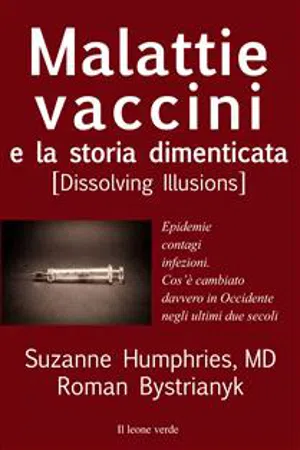
Malattie, vaccini e la storia dimenticata
dissolving illusion
- English
- ePUB (mobile friendly)
- Available on iOS & Android
About this book
Fino a qualche tempo fa le infezioni mortali erano molto temute in Occidente. Da allora, diversi Paesi hanno attraversato un'enorme trasformazione diventando più sicuri e più sani. Molte cose infatti sono mutate complessivamente nella vita sociale: dalla nuova sensibilità per l'ambiente alla legislazione sulla sicurezza sul lavoro, dalla maggiore consapevolezza dell'igiene a una migliore conoscenza dei bisogni alimentari. Le malattie infettive erano già in diminuzione a partire dalla metà del XIX secolo, e all'inizio del XX avevano raggiunto livelli significativamente più bassi. Questa trasformazione è una storia che parla di fame, di povertà, di sporcizia, di terapie dimenticate, di idee eugenetiche, di libertà personali contro il potere dello Stato, di proteste e detenzioni per il rifiuto dei vaccini e di molto altro ancora. Oggi ci viene insegnato da più parti che gli interventi medici sotto forma di vaccinazione sono la maggiore scoperta della medicina perché hanno aumentato la nostra aspettativa di vita e prevenuto le morti di massa. Ma questo corrisponde davvero alla verità? Suzanne Humphries e Roman Bystrianyk hanno investigato direttamente le fonti, ricercando e analizzando una miriade di documenti storici da metà Settecento ai giorni nostri. Libri e riviste mediche, eventi storici, rapporti scientifici, relazioni parlamentari, studi statistici e molta altra documentazione medica da tempo dimenticata. Il compendio di questa vastissima mole di informazioni è raccolto in questo libro: più di 50 grafici, decine di diagrammi e altre immagini storiche, insieme a un'abbondanza di citazioni e testimonianze, che illuminano le vere cause delle malattie e il nesso essenziale tra le condizioni di vita, l'alimentazione e la salute. Molti miti cadono, molte credenze si dissolvono, molte presunte certezze - divenute veri e propri dogmi quasi religiosi - evaporano.
Frequently asked questions
- Essential is ideal for learners and professionals who enjoy exploring a wide range of subjects. Access the Essential Library with 800,000+ trusted titles and best-sellers across business, personal growth, and the humanities. Includes unlimited reading time and Standard Read Aloud voice.
- Complete: Perfect for advanced learners and researchers needing full, unrestricted access. Unlock 1.4M+ books across hundreds of subjects, including academic and specialized titles. The Complete Plan also includes advanced features like Premium Read Aloud and Research Assistant.
Please note we cannot support devices running on iOS 13 and Android 7 or earlier. Learn more about using the app.
Information
Table of contents
- Copertina
- Colophon
- Avvertenza
- Riconoscimenti
- Prefazione, della dott.ssa Jayne L. M. Donegan
- Introduzione degli autori
- Glossario
- Il buon tempo antico, non poi così tanto buono…
- La sofferenza dei più piccoli
- La malattia – un modo di vivere
- Il vaiolo e il primo vaccino
- Vaccini contaminati
- La grande dimostrazione
- L’ esperimento ribelle
- Il potere dello stato
- Il caso di Arthur Smith Jr.
- La rivoluzione della salute
- Lo straordinario declino
- La “sparizione” della polio
- La pertosse
- Il morbillo
- Fame, scorbuto e vitamina C
- Rimedi dimenticati
- Credenze e paure
- Appendice
- Indice
- Note